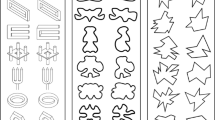Abstract
In two experiments, subjects received problem sets consisting of a simple diagram accompanied by two sentences and were asked to select the sentence that best expressed the meaning of the diagram. Each diagram showed a relationship between two concepts. The relationships were category membership, possession of a property, and causality. The relative placement of the concepts was varied. In the first experiment, the concepts were given nonsense names. Significant biases in response frequencies were found, suggesting that, in the absence of semantic content, the interpretation of the diagrams was largely determined by syntactic rules of English. In the second experiment, similar biases were found for diagrams whose concepts were given English names. However, the biases were less evident when the diagrams violated the rules of English syntax. This suggested that conflict between the sense of English and a diagram's spatial arrangement makes consistent interpretation unlikely. Conclusions are drawn concerning the relationships between the spatial arrangement of diagrams and the meaning of relationships among concepts stated in sentences. Suggestions for diagram design are offered.
Similar content being viewed by others
References
Armbruster, B. B., & Anderson, T. H. (1982).Idea mapping: The technique and its use in the classroom, or simulating the “ups” and “downs” of reading comprehension. (Reading Education Report #36). Urbana, IL: University of Illinois Center for the Study of Reading.
Armbruster, B. B., & Anderson, T. H. (1984). Mapping: Representing informative text graphically. In C. D. Holley & D. F. Dansereau (Eds.),Spatial learning strategies (pp. 189–209). New York: Academic Press.
Berkowitz, S. J. (1986). Effects of instruction in text organization on sixth-grade students' memory for expository reading.Reading Research Quarterly, 21, 161–177.
Breuker, J. A. (1984). A theoretical framework for spatial learning strategies. In C. D. Holley & D. F. Dansereau (Eds.),Spatial learning strategies. New York: Academic Press.
Geva, E. (1983). Facilitating reading comprehension through flowcharting.Reading Research Quarterly, 18, 384–405.
Guri-Rozenblit, S. (1988a). Impact of diagrams on recalling sequential elements in expository texts.Reading Psychology, 9, 121–139.
Guri-Rozenblit, S. (1988b). The interrelationships between diagrammatic representations and verbal explanations in learning from social science texts.Instructional Science, 17, 219–234.
Guri-Rozenblit, S. (1989). Effects of a tree diagram on students' comprehension of main ideas in an expository text with multiple themes.Reading Research Quarterly, 24, 236–247.
Holley, C. D., & Dansereau, D. F. (1984). The development of spatial learning strategies. In C. D. Holley & D. F. Dansereau (Eds.),Spatial learning strategies. New York: Academic Press.
Holliday, W. G., Brunner, L. L., & Donais, E. L. (1977). Differential cognitive and affective responses to flow diagrams in science.Journal of Research in Science Teaching, 14, 129–138.
Hughes, R. E. (1989).Radial outlining: An instructional tool for teaching information processing. Doctoral dissertation, University of Washington College of Education, Seattle.
Johnson, D. D., Pittelman, S. D., Heimlich, J. E. (1986). Semantic mapping.Reading Teacher, 39, 778–783.
Koran, J., & Koran, M. (1980). Interaction of learner characteristics with pictorial adjuncts in learning from science text.Journal of Research in Science Teaching, 17, 477–483.
Larkin, J. H., & Simon, H. A. (1987). Why a diagram is (sometimes) worth ten thousand words.Cognitive Science, 11, 65–99.
Prater, D. L., & Terry, C. A. (1988). Effects of mapping strategies on reading comprehension and writing performance.Reading Psychology, 9, 101–120.
Ruddell, R. B., & Boyle, O. F. (1989). A study of cognitive mapping as a means to improve summarization and comprehension of expository text.Reading Research and Instruction, 29, 12–22.
Salomon, G. (1979).Interaction of media, cognition and learning. San Francisco: Jossey-Bass.
Schewel, R. (1989). Semantic mapping: A study skills strategy.Academic Therapy, 24, 439–447.
Sinatra, R. C., Stahl-Gemake, J., & Berg, D. N. (1984, October). Improving reading comprehension of disabled readers through semantic mapping.The Reading Teacher, 37, 22–29.
Sinatra, R., Stahl-Gemake, J., & Morgan, N. W. (1986). Using semantic mapping after reading to organize and write discourse.Journal of Reading, 18, 4–13.
Tversky, B., Kugelmass, S., & Winter, A. (1991). Cross-cultural and developmental trends in graphic productions.Cognitive Psychology, 3, 515–557.
Winn, W. D. (1982). The role of diagrammatic representation in learning sequences, identification and classification as a function of verbal and spatial ability.Journal of Research in Science Teaching, 19, 79–89.
Winn, W. D. (1983). Perceptual strategies used with flow diagrams having normal and unanticipated formats.Perceptual and Motor Skills, 57, 751–762.
Winn, W. D., & Holliday, W. G. (1982). Design principles for diagrams and charts. In D. Jonassen (Ed.),The technology of text (pp. 277–299). Englewood Cliffs, NJ: Educational Technology Publications.
Winn, W. D., Li, T-Z., & Schill, D. E. (1991). Diagrams as aids to problem solving: Their role in facilitating search and computation.Educational Technology Research and Development, 39, 17–30.
Wong, T. H., & Kao, H. S. R. (1991). The development of drawing principles in Chinese. In J. Wann, A. M. Wing, & N. Sovik (Eds.),Development of graphic skills. New York: Academic Press.
Author information
Authors and Affiliations
Rights and permissions
About this article
Cite this article
Winn, W., Solomon, C. The effect of the spatial arrangement of simple diagrams on the interpretation of english and nonsense sentences. ETR&D 41, 29–41 (1993). https://doi.org/10.1007/BF02297090
Issue Date:
DOI: https://doi.org/10.1007/BF02297090




